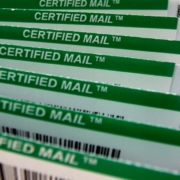What Should Your Healthcare Marketing Budget be in 2021
When most healthcare providers attend school, they don’t usually think about what it takes to run a practice; the last thing on their minds is a healthcare marketing budget – or any direct marketing plan. But planning to reach and acquire new patients is crucial if you want a thriving practice.
Why? Because no matter how exceptional your care, how much your patients love and trust you, some will leave your practice. Some patients will move out of the area, grow out of your specialty, or won’t be a fit for your practice.
If your patient acquisition plans don’t outpace the rate that patients leave, then your practice is at risk. To get the best results, use the best strategies to attract new patients.
Healthcare Direct Mail Marketing Delivers
 Why direct mail? Because people spend more time with it, it stays in the minds of your prospects longer, and it has a good rate of return. This isn’t just lip service, the statistics prove it:
Why direct mail? Because people spend more time with it, it stays in the minds of your prospects longer, and it has a good rate of return. This isn’t just lip service, the statistics prove it:
BMC Health Services Research demonstrates that healthcare direct mail marketing is an effective tool for patient acquisition and retention when it’s done properly. The overall message is to use organizations that are proficient in communicating to various patient streams.
42% of individuals look over their direct mail – which means that if you send out 1,000 postcards in a campaign, then 420 people looked at it. That’s an impressive rate.
73% of Americans say they prefer direct mail. When comparing direct mail to other methods of communication, including email, people prefer to receive mail.
Direct mail offers a 29% return on investment. So, if you spend $5,000 on your campaign, you can expect to make at least $6,450; a $10,000 campaign can expect a return of about $12,900. These numbers only show the results of a one-time purchase, the lifetime value of a new patient is much higher.
With impressive statistics like this, how much of your healthcare marketing budget should be allocated to direct mail?
Your Healthcare Marketing Budget
How much should you allocate to marketing? A good rule of thumb is between 5 to 10% of a practice’s revenue should go toward marketing [1], but if you’re building the practice or establishing a new practice, then as much as 12% should be allocated.
After you’ve determined the marketing budget, it’s time to decide what percentage should be spent on different marketing channels. To determine this, decide which channel will give you the best results.
Direct mail vs. email
 You may naturally think of email and digital marketing as inexpensive, easy options, but they don’t deliver the results that healthcare direct mail does. Plus, an effective email campaign requires an “opt-in” from the receiver – so it’s not the best option to gain new patients.
You may naturally think of email and digital marketing as inexpensive, easy options, but they don’t deliver the results that healthcare direct mail does. Plus, an effective email campaign requires an “opt-in” from the receiver – so it’s not the best option to gain new patients.
Plus, recipients remember direct mail longer than an email – direct mail has an average lifespan of 17 days. That’s because an attractive offer or colorful postcard will make it to the refrigerator, bulletin, or whiteboard. But emails are often victims of group email purges and not be thought of at all.
If you’re concerned that only older adults like direct mail, the Small Business Association says that younger individuals don’t look at direct mail as “junk mail” and often prefer direct mail to receive service and product offers.
People spend more with direct mail
According to a 2018 article by Email Insider, not only do they confirm direct mail’s prolonged shelf life and that Millennials like it, but they also show that direct mail recipients spend 5 times more than email recipients.
Cost of Patient Acquisition vs. Patient ROI
As mentioned above, your initial investment in a healthcare direct mail campaign will get about a 29% ROI, according to SEO marketing guru Neil Patel. Using this formula, the more you’re willing to invest, the bigger your return.
To calculate your ROI, use this handy calculator. Simply estimate the size of your direct mail campaign and other elements, including the initial fees new patients will pay, the percentage of new patients that will stay with your practice, and more. The tool will help you determine your break-even point and likely revenue for the campaign.
New patients who return and create long-term relationships with you, your staff, and patients can return a lifetime of value. What is that worth to you? More than the cost of a healthcare direct mail campaign.
Direct Mail Works for Patient Communication
Although acquiring new patients is important, retaining your patients is essential. You can use your patient list to send direct mail and communicate:
 Special holiday hours – It’s also important to communicate how to receive treatment when your office is closed.
Special holiday hours – It’s also important to communicate how to receive treatment when your office is closed.- Special protocols – The COVID-19 pandemic is creating concerns, which you can ease by sharing sanitation methods and mask-wearing requirements.
- How to reschedule missed appointments
- Telehealth offerings, virtual appointments, and other new services
- Office and service updates to keep the community close
A postcard, flyer-letter, or newsletter are wonderful ways to keep your practice top-of-mind. They also provide the perfect way for your patients to refer you with a “pass-along” communique that can give prospects an idea of what it will be like to become your patient.
The effectiveness of direct mail demonstrates the importance of establishing a healthcare direct mail budget for your practice. Direct mail delivers the best results and should have a significant portion of your budget. Choosing an expert to partner with you to develop and deploy direct mail campaigns deserves significant consideration.
One Stop Mail has experts who can assist you with every element of direct mail, including creating lists, eye-catching healthcare designs, and the highest quality offset and variable data printing. Contact us or give us a call at 602-233-3003 if you want to raise your ROI on your next healthcare direct mail marketing campaign.













Leave a Reply
Want to join the discussion?Feel free to contribute!